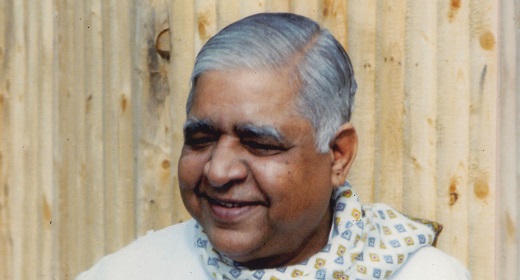by Wes Nisker: This interview grew out of several conversations between S. N. Goenka and Wes Nisker in December 1986…
It was originally published in Inquiring Mind, Volume 4, Number 1 (Summer 1987). It also appears in our book, The Best of Inquiring Mind: 25 Years of Dharma, Drama and Uncommon Insight (Wisdom Publications, 2008). We offer it again with our Fall 2013 issue to commemorate this beloved teacher’s death.
::
During the third century B.C., the teachings of the Buddha spread across the Indian subcontinent and into Southeast Asia under the auspices of the great Indian emperor Ashoka, also known as Dhammaraja, the King of Dhamma. According to legend, Ashoka’s chief Dhamma teacher sent two monks to Burma to offer the Triple Gem to the people there, and as he sent them off he made this prediction: the Dhamma would one day disappear from India and the rest of the world but would be preserved in its pure form in Burma, the Golden Land. The teacher also predicted that 2,500 years after the Buddha, the Dhamma would be transported from Burma back to India and from there it would spread throughout the world.
This prophecy is now being fulfilled to some degree through the work of S. N. Goenka, or Goenkaji, as he is affectionately known, one of the most influential Dhamma teachers in the world today. Goenka was born in 1923 into a wealthy Indian family living in Rangoon, Burma. As a young man he became very successful in business and at the same time began developing severe migraine headaches. Goenka traveled around the world searching in vain for treatments and cures until finally, back home in Rangoon, he began studying vipassana meditation with Sayagyi U Ba Khin. Eventually his headaches went away, but more than that, his life was transformed. Goenka became a devoted follower of the Buddha’s path.
In 1969, Goenka moved to India, where he began teaching vipassana, helping to bring this age-old meditation practice back to the land of its origin. Since then he has taught thousands of people and has established meditation centers in India, America, Europe, and Australia.
A three-hour train ride from the urban chaos of Mumbai (Bombay) on a hill overlooking the rural Indian town of Igatpuri, Goenka built Dhamma Giri, which serves as his main meditation center. Established in 1976, Dhamma Giri features a large Burmese-style pagoda, a spacious meditation hall, and over 300 individual meditation cells where students can practice in isolation. The grounds are planted with flowers and fruit trees, the living quarters are comfortable, and the food is clean and nourishing. Inside Dhamma Giri the purity is tangible.
S.N. GOENKA: Purity is very important because what is going on at meditation retreats is nothing less than surgery on the mind. When you have surgery on your body, you go to the surgery theater, which is kept very pure. No contamination is allowed because a wound is being opened, and if some outside dirt gets in, it will cause infection. It is the same in this surgery of the mind.
INQUIRING MIND: The meditation retreats at Dhamma Giri include people from many nations and from a variety of religious and economic backgrounds. You tell them that you are not teaching Buddhism but simply the laws of nature.
SNG: Buddha’s pure teaching is nothing but the law of nature. The Buddha himself said that whether there is a Buddha in the world or no Buddha in the world, the law of nature remains. If you generate craving and aversion in the mind, you are bound to become miserable. If you want to come out of your misery, then get rid of craving and aversion. This is just the law of nature, and this law is applicable in every culture.
Even people who belong to sects that are totally opposed to Buddhism are now coming to take these vipassana meditation courses. For example, for twenty-five centuries in India the Jain community has been teaching that the Buddha’s path is wrong. The same with the Hindu community. I was born in a conservative Hindu family, and from childhood we were taught that even if you are going down a very narrow lane and a wild elephant is coming at you about to crush you, and you see an open door of a Buddhist temple on your right and an open door of a Jain temple on your left, it is better to get crushed by the elephant than to escape through those doors. But now there are a great many of these Hindus and Jains coming to the meditation courses. Once the practice is established, it is all just the law of nature. The law of nature does not give preference to a Christian or to a Hindu. If you place your hand on the fire, your hand will burn. It is so simple. This is the Dhamma. I have no belief in Buddhism. I believe only in Dhamma. For me Hinduism and Buddhism are both madness.
IM: When you are teaching the Dhamma, do you find that the Indian students are different from Westerners? And do you ever alter your teaching to accommodate people of different cultures?
SNG: The basic teaching remains the same and the meditation technique remains the same. But there are some differences. The Indians have more trouble with their philosophical beliefs, especially concerning the “soul.” One community believes that the soul is the size of the thumb. Another believes that it is the size of a persimmon seed. And there are so many different gods here in India, gods with two hands or four hands, gods of this shape or that color. So I tell the Indians that it is all right to believe in this kind of soul or that kind of soul, or this god or that god, but you still have to purify your mind. Otherwise you will remain miserable.
On the other hand, when I am teaching Indians, I don’t need to place so much emphasis on sila (morality). It is not that the people in India are full of sila, but at least they understand sila and it is very important to them. So I don’t need to talk too much against free sex or drugs. But in the West, I have to give more emphasis to those issues.
IM: Many spiritual teachers who have come to the West in the past few decades have been discredited or somehow mixed up in scandal involving sex, drugs, and money. Why do you think this is occurring so frequently?
SNG: Well, if some teacher goes to the West with the ambition to acquire material wealth, then this person has nothing to do with Dhamma. The meditation techniques can be kept pure, the Dhamma can be kept pure only if the teacher expects nothing in return, not even any fame or status. If there is any such craving in the mind of a teacher, then this person is not worthy of becoming a teacher. If a teacher is a monk, then he must beg for his food, and if the teacher is a householder, then he or she must have another means of livelihood. The teaching of Dhamma cannot be a means of livelihood.
Another problem for many teachers in the West is the great freedom of sex that exists there. But how can any vipassana teacher even think of passion towards his own students of the opposite sex? For vipassana teachers all female students are their daughters and all male students are their sons. Everyone who received the Dhamma from the Buddha was his child. If you are teaching Dhamma, that means you are giving people a new life, a new birth, and those people then become your children. If a teacher has sexual relations with a student, you will not have pure Dhamma.
IM: Do you feel that Westerners are more attached to the concept of self than the Indians?
SNG: If by self you mean a soul, then the Indians have a harder time with it. But when you talk of self as ego, then it is the same everywhere. In Burma, India, or America, people are mad with their ego. That is why the meditation technique is most important. The technique is to dissolve the ego.
IM: However it is undoubtedly more difficult for Westerners to accept some of the traditional Buddhist beliefs, such as the idea of rebirth. How does this affect their meditation practice?
SNG: A belief in rebirth is not important, but as you develop in vipassana, it will become clear to you by your own understanding. Anyway, to me this present life is much more important than a future life. Why worry about a future life? If you do something to better your present life, then your future life will automatically become better. But if you are doing something for a future life and it doesn’t help you in your present life, then to me it is useless.
IM: You teach a meditation practice that involves moving the mind through the body and focusing on physical sensations. This technique has become widely known as the “body scan,” and sometimes is called “sweeping.” What is the origin of this technique?
SNG: Buddha is the origin! (Laughs) Nobody else can be the origin. In the Satipatthana Sutta there are the words, “Sabbakaya-patisamvedi assasissamiti sikkhati… passasissamiti sikkhati.” (Feeling the whole body I shall breathe in… feeling the whole body I shall breathe out.) One should learn how to feel the entire body in one breath, breathing in and breathing out. Perhaps I am responsible for calling it “sweeping,” but this is the Buddha’s teaching.
The whole technique of the Buddha is to move you from the gross level of reality to the subtle. The apparent truths are always gross and solidified, full of illusions and delusions. The purpose of vipassana meditation is to penetrate the gross and go to the ultimate truth. The ultimate truth of mind and body is nothing but vibration, and that is what you are observing when you practice this technique.
IM: In this meditation practice, you do not give much emphasis to cittanupassana (observation of mind) or dhammanupassana (observation of mental contents). Is there a reason for this?
SNG: Observing thoughts is never taught by the Buddha. In the Satipatthana Sutta in the section on cittanupassana, the Buddha says, “Here a bhikkhu understands properly mind with craving as mind with craving.” Craving for what is not important. If you observe the thought, then you start rolling in its contents. So instead you simply observe that craving has started in the mind, and at the same time you feel the arising and passing away of sensations in the body. If you are equanimous with the sensations, then you are also equanimous with the craving, and in this way, layer after layer of that particular sankhara (reaction) in your mind will be erased automatically.
IM: It sounds like you are dealing here with a very deep, subconscious level of the mind.
SNG: Yes, and that is why this technique was developed by the Buddha. First he had tried eight jhanas (levels of absorption), which had purified his mind, but not to the depth. Deep inside there was what the Buddha called “sleeping impurities,” meaning that the roots of the impurities were still there. He realized that these could be taken out only through the practice of vipassana, through awareness of sensations.
Buddha understood that the unconscious mind is constantly in contact with the body sensations. So if we are going to purify the unconscious mind, we have to work with these sensations. If you forget the sensations of the body, then you are dealing only with the surface of the mind. The surface of your mind will become purified and you will benefit from that also, but those complexities lying deep below, the deep conditioning of the past, will remain unchanged.
IM: So you are training the mind not to react in a habitual way to any sensations that may arise.
SNG: Yes, exactly. Whatever external event happens will generate sensations in the body, and you will have trained your mind to be equanimous with those sensations. So you are at the roots. If the roots are healthy, then the tree will automatically be healthy. You need not worry. This is how it works.

















































